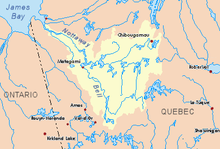Loading AI tools
River in Quebec, Canada From Wikipedia, the free encyclopedia
The Nottaway River is a river in Quebec, Canada. The river drains Lake Matagami and travels 225 kilometers (140 mi) north-west before emptying into Rupert Bay at the south end of James Bay. Its drainage basin is 65,800 square kilometers (25,400 sq mi) and has a mean discharge of 1190 m3/s (1556 yd3/s). Its source is the head of the Mégiscane River, which is 776 kilometers (482 mi) from the mouth.[1]
| Nottaway | |
|---|---|
 Nottaway River basin in yellow | |
| Location | |
| Country | Canada |
| Province | Quebec |
| Region | Jamésie |
| Physical characteristics | |
| Source | Lake Matagami |
| • location | Matagami |
| • coordinates | 50°03′00″N 77°28′10″W |
| Mouth | Rupert Bay off James Bay |
• location | About 17 km SW of Waskaganish |
• coordinates | 51°23′30″N 78°48′00″W |
• elevation | 0 m (0 ft) |
| Length | 200.2 km (124.4 mi) |
| Basin size | 65,800 km2 (25,400 sq mi)[1] |
| Discharge | |
| • average | 1,190 m3/s (42,000 cu ft/s)[1] |
| Basin features | |
| Tributaries | |
| • left | (upstream from the mouth)
|
| • right | (upstream from the mouth)
|
Significant lakes along its course are Soscumica Lake (50°15′N 77°27′W) and Dusaux Lake (50°45′00″N 77°53′30″W).
The Nottaway, together with the Broadback and Rupert Rivers, was initially considered to be dammed and developed as part of the James Bay Project. But in 1972 hydro-electric development began on the more northerly La Grande and Eastmain Rivers, and the NBR Project was shelved. With the decision to divert the Rupert River to the La Grande, it is not likely that the Nottaway will be developed in the foreseeable future.
Nottaway means the lower course of Lake Matagami and a length of 200.2 kilometres (124.4 mi), of a watercourse which originates in the Mégiscane Lake. The whole is a long river of 776 kilometres (482 mi) units flowing through many lakes. On the way to the northwest, the Nottaway, from Lake Matagami, creates the lakes of Soscumica and Dusaux, collects the waters of several rivers - notably the Kitchigama River and ends its race in Rupert Bay at the southern end of James Bay, at the western area of the Broadback River and Rupert River.
Its drainage basin is 65,800 square kilometres (25,400 sq mi) and has an average discharge of 1,190 cubic metres per second (42,000 cu ft/s). The course of the river crosses many marsh areas, especially in its lower part.
The mouth of Matagami Lake is located:
From the mouth of Matagami Lake, the Nottaway River flows on 200.2 kilometres (124.4 mi) divided into the following segments:
(from the mouth) Lemoine Island, Lavoie Island, Kakupanchish Island, Kaminahikushach Island, Misiministikw Island, D'Herbomez Island, Des Sept Miles Island, Interdite Island (Bras Kapakusipastikuch), Vandry Island (Bras Spipastikw), Desmolier Island, Michikushish Island, Nestipuku Island, Kauskatistin Island.
(from the mouth) Rapides Kanutinitunanuch, rapides Kasischischiskasich, rapides Kaikunapischechuch, rapides Kachechekuch, Iroquois Falls, rapides Longs, rapides des Taureaux.
Major tributaries of the Nottaway River include:
In the seventeenth century, the Iroquois invaded the Algonquin territory near James Bay along this river. So when European cartographers started to map the river in the late seventeenth century, they called it "Rivière des Iroquois" (Iroquois River), as shown on maps of Jean-Baptiste-Louis Franquelin in 1699, Guillaume Delisle in 1703, and Jacques-Nicolas Bellin in 1744.[3]
Yet various forms of "Nottaway" started to appear in the early 18th century. "Noddaways" in 1715, "Nodaway" in 1743, "Nodaoay" and "Nodway" in 1744. Geologists James Richardson and Albert Peter Low used "Notaway River" in their reports (of 1880 and 1885 respectively). The current spelling "Nottaway" was established in the early twentieth century. It is believed to have come from the Algonquin word nadowe, meaning "snake" and which the Algonquin tribes used to identify or describe their enemies, including the Iroquois. The Cree called this river Natuweu Nipi, and the Iroquois name was Nottaweou.[3]
Seamless Wikipedia browsing. On steroids.
Every time you click a link to Wikipedia, Wiktionary or Wikiquote in your browser's search results, it will show the modern Wikiwand interface.
Wikiwand extension is a five stars, simple, with minimum permission required to keep your browsing private, safe and transparent.